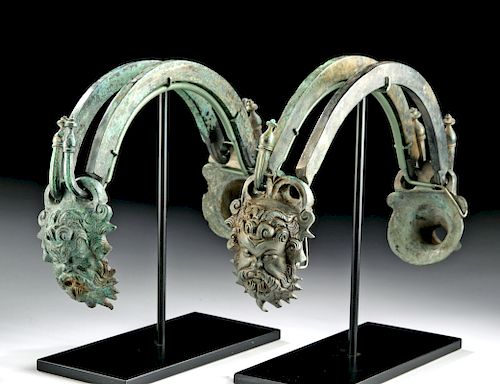Greek Hellenistic Bronze Situla Handles (matched pr)
Lot 39
About Seller
Artemis Fine Arts
686 S Taylor Ave, Ste 106
Louisville, CO 80027
United States
Selling antiquities, ancient and ethnographic art online since 1993, Artemis Gallery specializes in Classical Antiquities (Egyptian, Greek, Roman, Near Eastern), Asian, Pre-Columbian, African / Tribal / Oceanographic art. Our extensive inventory includes pottery, stone, metal, wood, glass and textil...Read more
Estimate:
$7,000 - $14,000
Absentee vs Live bid
Two ways to bid:
- Leave a max absentee bid and the platform will bid on your behalf up to your maximum bid during the live auction.
- Bid live during the auction and your bids will be submitted real-time to the auctioneer.
Bid Increments
| Price | Bid Increment |
|---|---|
| $0 | $25 |
| $300 | $50 |
| $1,000 | $100 |
| $2,000 | $250 |
| $5,000 | $500 |
| $10,000 | $1,000 |
| $20,000 | $2,500 |
| $50,000 | $5,000 |
| $100,000 | $10,000 |
| $200,000 | $20,000 |
About Auction
By Artemis Fine Arts
Sep 26, 2019
Set Reminder
2019-09-26 10:00:00
2019-09-26 10:00:00
America/New_York
Bidsquare
Bidsquare : Exceptional Day 1: Antiquities & Asian Art
https://www.bidsquare.com/auctions/artemis-gallery/exceptional-day-1-antiquities-asian-art-4437
Day 1 of an important 2-day auction featuring exceptional, museum-worthy examples of Egyptian, Greek, Etruscan, Roman, Viking, Russian, Near Eastern, as well as Asian Art from China, Japan, Thailand, Vietnam, Burma and India. Artemis Fine Arts info@artemisfinearts.com
Day 1 of an important 2-day auction featuring exceptional, museum-worthy examples of Egyptian, Greek, Etruscan, Roman, Viking, Russian, Near Eastern, as well as Asian Art from China, Japan, Thailand, Vietnam, Burma and India. Artemis Fine Arts info@artemisfinearts.com
- Lot Description
Ancient Greece, early Hellenistic period, ca. late 4th to 3rd century BCE. A beautiful pair of cast-bronze situla handles with three primary components. Each handle is comprised of a pair of semicircular grips with upturned baluster terminals on each end. The handles are held in place by components presenting mesmerizing visages on each side - a stylized lion head with an open mouth that doubles as a spout on one end and a bearded satyr, perhaps Silenus, on the other. Above the heads of the lions and satyrs are two petite loops through which the handle terminals are fed. Each component is covered in gorgeous green and turquoise patina, imbuing it with an elegant presentation characteristic of finely crafted Greek bronze. Rare to find a matched pair! Size: 8.5" L x 5.125" H (21.6 cm x 13 cm); 6.875" H (17.5 cm) on included custom stand.
In addition to being beautifully rendered in bronze, these handles present highly symbolic iconography. The satyrs adorning these situla handles likely depict Silenus. Silenus was the mythical teacher and drinking companion of Dionysos (Roman Bacchus), god of wine, winemaking, and the grape harvest - and furthermore, by virtue of the inebriated state brought about by the ingestion of such fermented libations of the vine, the deity also associated with madness, theatre, and spiritual ecstasy. The consumption of wine was an important social activity in ancient Greek society, and Silenus was oftentimes used to adorn special objects and signify the owner's affiliation with the cult of Dionysus (Bacchus).
On the other ends of the handles, we have lion spouts. In the classical world, lions symbolized power, wealth, and might. They were famously featured in many ancient myths, perhaps the most famous being that of Herakles (Roman Hercules) slaying the Nemean lion for his first labor. That lion's fur was believed to be impenetrable to attacks since according to legend it was made of gold and its claws were far sharper than swords with the power to slice through armor. In the end, Herakles defeated the lion by strangling it and wore its skin. Lions were also favorite iconography for buildings, coins, and statues in the ancient world. Examples include the Lion Gate to the Citadel of Mycenae, the Terrace of the Lions on the island of Delos, and the lion hunt mosaic from Pella featuring Alexander engaged in a lion hunt.
Bonhams London sold a similar handle - but ONLY ONE and it was missing one of the maskettes - for 3,500 pounds ($4,280) - 6 July 2017, lot 106 - https://www.bonhams.com/auctions/24098/lot/106/
Provenance: private East Coast, USA collection
All items legal to buy/sell under U.S. Statute covering cultural patrimony Code 2600, CHAPTER 14, and are guaranteed to be as described or your money back.
A Certificate of Authenticity will accompany all winning bids.
We ship worldwide and handle all shipping in-house for your convenience.
#148401End of one semicircular grip is missing its baluster terminal. One of the semicircular grips of the other handle displays some bending to its baluster terminals. There are small areas of loss to the periphery of one lion head. Both satyrs have a small loss to a lower beard tendril. Otherwise, these are very well preserved.Condition
- Shipping Info
-
All shipping is handled in-house for your convenience. Your invoice from Artemis Gallery will include shipping calculation instructions. If in doubt, please inquire BEFORE bidding for estimated shipping costs for individual items.
-
- Buyer's Premium



 EUR
EUR CAD
CAD AUD
AUD GBP
GBP MXN
MXN HKD
HKD CNY
CNY MYR
MYR SEK
SEK SGD
SGD CHF
CHF THB
THB















